Are Winter Hikes of the Appalachian Trail the Next Thing?
Winter hikes of the Appalachian Trail are gaining popularity as more and more hikers seek a unique and challenging experience. With stunning snow-covered landscapes and fewer crowds, the winter season offers a different perspective of the iconic trail. However, winter hiking on the Appalachian Trail comes with its own set of challenges, including unpredictable weather and harsh conditions. Proper gear, experience, and knowledge of winter hiking are essential for those attempting this adventure. Despite the challenges, the allure of a quieter and more serene trail experience is attracting more hikers to explore the Appalachian Trail in the winter months.

Are Winter Hikes of the Appalachian Trail the Next Thing?
The Appalachian Trail is a breathtaking, 2,200-mile long hiking trail that stretches from Georgia to Maine, offering hikers a chance to immerse themselves in the natural beauty of the eastern United States. Traditionally, the trail sees the majority of its traffic during the spring and summer months, when the weather is mild and the trail is at its most hospitable. However, there is a growing trend among outdoor enthusiasts to take on the challenge of hiking the Appalachian Trail during the winter months. As the popularity of winter hiking continues to rise, many are left wondering if winter hikes of the Appalachian Trail are the next big thing in outdoor adventure.
Winter hiking on the Appalachian Trail presents a unique set of challenges and rewards, making it an appealing option for those who are looking to push themselves to the limit and experience the trail in a completely different light. The winter landscape offers a stark contrast to the lush greenery and vibrant colors of spring and summer, with snow-covered mountains, frozen waterfalls, and icy streams creating a serene and otherworldly atmosphere. For those who are willing to brave the cold and embrace the solitude, a winter hike on the Appalachian Trail can be an incredibly rewarding and transformative experience.
One of the main reasons why winter hikes of the Appalachian Trail are gaining popularity is the sense of adventure and challenge that comes with tackling the trail in the colder months. Winter hiking requires a different set of skills and gear compared to hiking in warmer weather, as hikers must be prepared to navigate through snow and ice, endure freezing temperatures, and contend with shorter daylight hours. This presents a thrilling and daunting challenge for those who are seeking a more intense and demanding outdoor experience.
In addition to the physical and mental challenges, there is also a unique sense of solitude and tranquility that comes with winter hiking on the Appalachian Trail. With fewer hikers on the trail, winter hikers have the opportunity to experience the natural beauty of the trail in a more intimate and undisturbed setting. The snow-covered landscapes and frozen waterways create a sense of serenity and peacefulness that is unmatched by any other season, allowing hikers to connect with nature on a deeper level and experience a profound sense of solitude and self-discovery.
Despite the allure of the winter landscape and the sense of adventure and solitude that comes with winter hiking, there are also some significant risks and challenges that must be taken into consideration. The harsh and unpredictable winter weather can pose serious dangers to hikers, including hypothermia, frostbite, and avalanches. Additionally, the trail conditions can be treacherous, with icy and snow-covered terrain making it difficult to navigate and increasing the risk of slips and falls. For these reasons, winter hiking on the Appalachian Trail is not for the faint of heart and requires a high level of skill, experience, and preparation.
In order to safely and successfully hike the Appalachian Trail in the winter, hikers must be equipped with the proper gear and knowledge to handle the challenges of the trail. This includes cold-weather clothing, insulated sleeping gear, and reliable traction devices for navigating icy terrain. Hikers must also be well-versed in winter survival skills, such as building snow shelters, navigating in whiteout conditions, and treating cold-weather injuries. Additionally, it is crucial for hikers to carefully plan their route, taking into account the unique challenges of winter hiking and being prepared to adjust their plans based on the ever-changing weather and trail conditions.
As the popularity of winter hikes of the Appalachian Trail continues to grow, it is important for hikers to approach this endeavor with caution and respect for the trail and its natural surroundings. The Appalachian Trail is a fragile and pristine wilderness that must be protected and preserved for future generations to enjoy. Hikers must adhere to Leave No Trace principles, minimize their impact on the environment, and prioritize safety and conservation above all else.
In conclusion, winter hikes of the Appalachian Trail offer a one-of-a-kind outdoor adventure that is both challenging and rewarding. The harsh and unforgiving winter landscape presents a unique set of challenges and risks, but also offers a sense of solitude and tranquility that is unmatched by any other season. For those who are willing to embrace the cold and push themselves to the limit, a winter hike on the Appalachian Trail can be a transformative and unforgettable experience. However, it is important for hikers to approach this endeavor with caution, respect, and a deep appreciation for the natural beauty of the trail.






